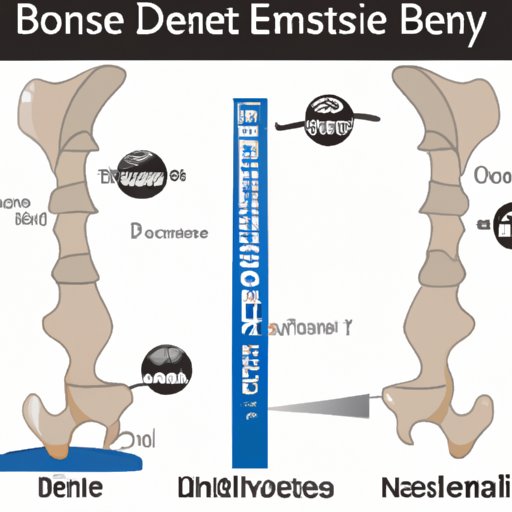
Introduction
If you’re concerned about the strength and health of your bones, you may want to consider taking a bone density test. This test is a safe and painless way to assess your bone density and determine your risk for osteoporosis, a condition that causes bones to become weak and brittle over time. In this article, we’ll provide a step-by-step guide to bone density testing, as well as information on what patients can expect, who should get tested, and how to interpret your results.
Step-by-Step Guide
Before getting started, it’s important to find a reputable provider who can perform the test and interpret your results. Once you’ve found a provider, the testing process itself is relatively straightforward and can typically be completed within a few minutes.
First, you’ll need to lie down on a padded table while a machine called a densitometer takes measurements of your bones. The densitometer emits a small amount of radiation, but this amount is generally considered to be safe and poses little risk to patients.
The machine will take measurements of your spine, hips, or other areas of your body, depending on the type of test you’re getting. You may also be asked to change positions or hold still during the test to help ensure accurate readings.
Once the test is complete, your provider will be able to analyze the results and provide you with a score that indicates the density of your bones.
What to Expect
Getting a bone density test is generally a painless and straightforward experience, but patients may need to take certain precautions or make preparations in advance of the test.
For example, patients may need to avoid wearing clothing with metal fasteners or buttons during the test to avoid interference with the machine’s readings. Patients may also need to avoid taking certain medications or supplements in advance of the test, so be sure to discuss any medications you’re taking with your provider prior to the test.
During the test, patients may feel a little pressure or discomfort as they lie on the table or move into different positions. However, this discomfort is usually minimal and not a cause for concern.
Benefits and Risks
There are several benefits to getting a bone density test, including early detection of bone loss and increased risk for fractures or other bone-related conditions. Additionally, bone density testing can help patients make informed decisions about lifestyle changes or medical treatments that can help them maintain or improve their bone health.
However, there are also some potential risks associated with bone density testing, including exposure to radiation and the possibility of false-positive or false-negative results. To minimize risks, it’s important to choose a reputable provider and to follow all instructions provided prior to the test.
Who Needs a Test
While anyone can benefit from having their bone density tested, some individuals may be at higher risk for developing osteoporosis or other bone-related conditions. These individuals may include older adults, postmenopausal women, and individuals with a family history of osteoporosis or other bone-related conditions.
It’s generally recommended that individuals get their first bone density test at age 50, although this may vary depending on individual risk factors and medical history. Your provider can recommend a testing schedule that’s right for you based on your age, overall health, and other factors.
Understanding Results
The results of a bone density test can be categorized in several different ways, depending on the type of test you’re getting and the areas of your body being measured. However, in general, a higher score indicates greater bone density and lower risk for osteoporosis and other bone-related conditions.
If your test results indicate that you have low bone density or are at increased risk for bone-related conditions, your provider may recommend lifestyle changes such as increased exercise or changes to your diet, or medical treatments such as medications or supplements to improve bone health. Your provider can work with you to develop a treatment plan that’s right for your individual needs and situation.
Preparing For Your Test
Prior to getting a bone density test, patients may need to take certain precautions or make certain preparations to help ensure accurate results. For example, patients may need to avoid wearing clothing with metal buttons or fasteners, avoid taking certain medications or supplements, or follow other instructions provided by their provider to help ensure accurate results.
To make the testing process as easy and stress-free as possible, it can also be helpful to wear comfortable, loose-fitting clothing and to arrive at the testing facility a few minutes early to complete any necessary paperwork or check-in procedures.
Conclusion
Overall, getting a bone density test is a simple, painless way to assess your bone health and determine your risk for osteoporosis and other bone-related conditions. By following the steps outlined in this article and working with a reputable provider, you can take control of your bone health and make informed decisions about lifestyle changes and medical treatments that can help you maintain strong, healthy bones for years to come.




